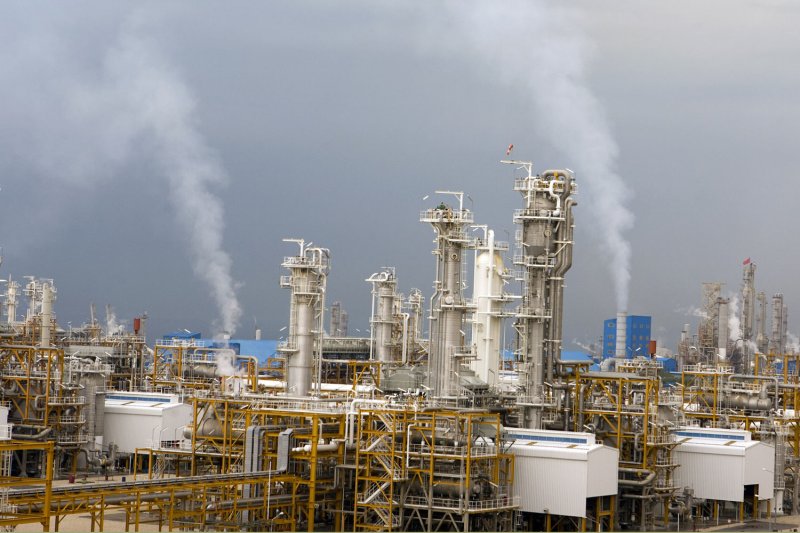Iran says it's discovered a big energy resource field, said to hold 50 trillion cubic feet of natural gas, in the disputed Caspian Sea but efforts to exploit it are likely to be undercut by international sanctions that will block needed foreign investment for its energy industry.
UPI/Maryam Rahmanian |
License Photo
BAKU, Azerbaijan, Dec. 16 (UPI) -- Iran says it's discovered a big energy resource field, said to hold 50 trillion cubic feet of natural gas, in the disputed Caspian Sea but efforts to exploit it are likely to be undercut by international sanctions that will block needed foreign investment for its energy industry.
"It's predicted that after examination the gas in this field will add up to much more than this," Iranian Oil Minister Rostam Qassemi declared Monday.
Meantime, neighboring Russia, a major Caspian stakeholder and which has a fluctuating relationship with the Islamic Republic, is beefing up its naval forces in the largest landlocked sea to back up Moscow's claims to its treasures.
EU leaders have called for sanctions against Iraq's oil exports by the end of January to tighten pressure on Tehran to abandon its contentious nuclear program. The sanctions would strike at a vital source of Iranian revenue and intensify the impact of three earlier rounds of sanctions by the United Nations, the United States and the European Union since June 2010.
Iran has proven gas reserves of 1,045 tcf, the equivalent of 216 billion barrels of oil and the second largest after Russia. The U.S. Geological Survey has estimated Iran has undiscovered gas reserves of 200-800 tcf.
Iran needs investment of $15 billion a year to expand its annual gas production to 11 tcf by 2014. It also wants to invest $50 billion in liquefied natural gas in the next decade on LNG projects to develop an export level of 8 million tons a year.
The proposed EU sanctions aimed at throttling Iranian oil exports could cause severe economic disruption on top of the damage done over the last 18 months.
The new sanctions have been blocked by differences among the 27 EU states, with Germany and France supporting the move and other states, such as Greece, blocking it.
Iran is the second ranking oil producer in the Organization of Petroleum Exporting Counties, with 26 million barrels per day, after Saudi Arabia.
"Iran is a major oil producer, and any sanctions on our oil exports will harm the global market," Qassemi declared.
He said the new Caspian strike was made at 2,300 feet in Iranian waters in the southern end of the sea.
The Caspian Basin has been touted as a rival to the Persian Gulf as a source of oil after major new strikes were made two decades ago, mainly by Azerbaijan, a former Soviet republic now increasingly aligned with the West.
The Caspian littoral includes Kazakhstan and Turkmenistan and despite a decade of negotiations no formal agreement on how its energy wealth will be divided has been reached.
The Americans and their European allies have striven to ensure that the oil and gas pumped from the Caspian goes westward via the 1,200-mile Baku-Tbilisi-Ceyhan pipeline from Azerbaijan via Georgia to Turkey's Mediterranean terminal at Ceyhan, and not to Russia or Iran.
Iran and Russia are the pivotal adversaries in the Caspian and both sides have been boosting military forces around the largest body of enclosed water in the world, all 143,200 square miles of it.
Adm. Vladimir Vysotsky, Russia's naval commander, has said that the Caspian Sea flotilla will receive up to 16 new ships over the next decade and added air assets deployed with Russia's southern command.
The Iranians' biggest concern is that Moscow will deploy shore-based Bastion anti-ship systems equipped with the supersonic P-800 Yakhont cruise missiles that are powerful enough to take out an aircraft carrier.
The Yakhont, known in the West as the SS-N-26, has a range of 190 miles, a maximum speed of 1,900 mph and carries a warhead of 440 pounds of high explosives. It can also wave-hop, making it extremely difficult to detect. The Iranians have nothing to match -- or counter -- it.
The most powerful warship cruising the Caspian is the Russian frigate Tatarstan, armed with Uran missiles with a range of 100 miles. It will soon be joined by a sister ship, the Dagestan.
The Iranian navy has around 100 small craft, an obsolete minesweeper and reportedly three Iranian-built midget submarines of North Korean design, useful for carrying frogmen on sabotage missions.















